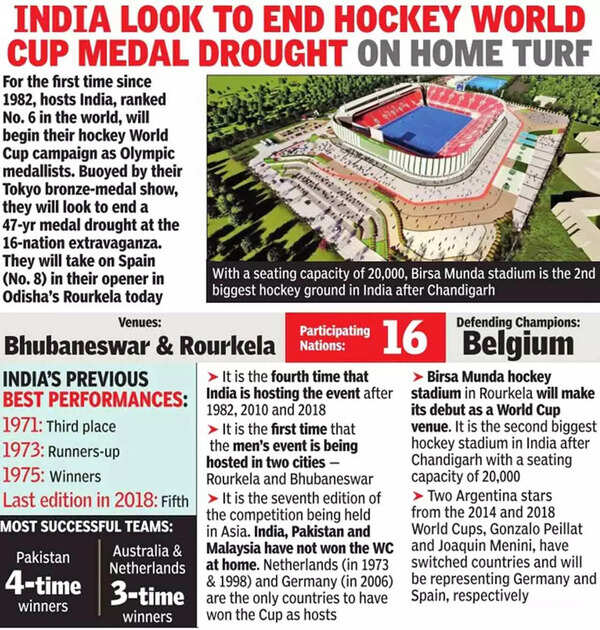On paper, however, there is a welcome dissimilarity from any World Cup India played since 1982 in Bombay. As the bronze medalist from the Tokyo Olympics in 2021, this World Cup will be the first time that an Indian team will play as a medallist from the last Olympics.
Just 526 days after winning bronze at the Tokyo Games, India will take on Spain to open their World Cup campaign on Friday at the multi-million Birsa Munda Hockey Stadium (BMHS) in Rourkela — a jaw-dropping spectacle worth more than Rs 250 crores.
The BMHS has been the centre of attraction in the build-up to the World Cup — for its magnificence as well as the ongoing construction activity even on the day before the tournament starts. But things that matter the most are in readiness to raise the curtain over the tournament.
The 15th edition of the men’s World Cup opened with a starry ceremony on January 12, but for some reason not at the two World Cup venues. It was held in Cuttack, which surprised many.
The competition will open first at Bhubaneswar’s Kalinga Stadium, the co-host for the first ever twin-city men’s World Cup, with two afternoon games on Friday. Rourkela will host the two evening fixtures of the opening day, including India’s first pool match against Spain, which starts at 1900 IST.
The world No. 6 Indian team, placed in Pool D alongside England, Spain and debutants Wales, gave final touches to its preparations on Thursday — as coach Graham Reid ran last-minute checks focused primarily on the defenders’ positions inside the circle and the penalty-corner routines.

The penalty corners is a territory of India captain and ace drag-flicker Harmanpreet Singh, who replaced Manpreet Singh as skipper in the later half of 2022.
The analyses of India’s squad have revolved around the thin back-up for Harmanpreet in the drag-flick department, as the other specialist Jugraj Singh has been put among the two reserves.
But Harmanpreet differs, putting his weight behind vice-captain Amit Rohidas, Varun Kumar and local boy Nilam Sanjeep Xess as capable alternatives to convert penalty corners.
“I would say we have good drag-flickers. We have four in the team. We have variations and need to use those well,” said the Indian skipper.
On paper India’s toughest pool game seems to be against England on Jan 15, before they conclude their pool engagements on Jan 19 against Wales in Bhubaneswar. But Spain’s tenacity can never be underestimated, especially after they roped in the wily Max Caldas as coach last year.
The Spaniards, however, are banking on youth, which is in stark contrast to India who have players like PR Sreejesh playing in his fourth World Cup and third on Indian soil. But the Spanish team does have players like Joaquin Menini, the Argentine who won the 2016 Rio Olympics gold but switched to Spain after a fallout with the Argentina federation.
“Beware of youth; they have the ability to perform much higher than what perhaps they think they can, and there is no fear. They have nothing to lose. You better watch out for those sorts of teams. That’s the reality,” said India coach Reid on Spain’s young squad.
“I think experience is a little bit overrated sometimes, especially in a big tournament like this. We just have to play our best. That’s the key to this tournament for us, about performing where we can and being able to achieve that,” Reid, who joined the Indian team as coach after the last World Cup, added.
It will be also interesting to see how the Spanish team, which has started making its presence felt again in world hockey, handles the pressure of playing in a stadium packed with fans shouting for India.
Reid said while crowd support does motivate the players, it can also become a double-edged sword if not soaked in.
“It is about staying in the moment. That’s what we talk a lot about, staying focused. If pressure is getting to you, if you have nerves, it means that you are off-task. It means you are either thinking about something that is going to happen in the future or something that has happened in the past,” said the India coach.
“So it’s a matter of understanding and getting to that point where you can let it motivate you, as you say, but you don’t go over the top.”
It’s easier said than done, when you know you have to finish on top to avoid the pressure of that extra match in the crossovers.
The top team from each of the four pools gets a direct entry into the quarterfinals, while the teams finishing second and third play the crossover matches.
India’s pool is by far the toughest of the four, with Australia expected to top Pool A. There could be a tussle between defending champions Belgium and Germany for the top spot in Pool B, and the Netherlands would fancy their chances of a direct entry into the quarters from Pool C.
That leaves Pool D the most open, and possibly the pool of death, with England, India and Spain all in a race that may end in a photo-finish for the top spot.
Friday is a big day and the steel city of Rourkela, which has been decked up for the World Cup, is expected to be buzzing in and around the massive ‘bowl’ of the Birsa Munda Hockey Stadium. And If India have learnt their lessons well and can recreate Tokyo in Odisha, a longstanding ‘hope’ will get fulfilled and a painful ‘wait’ will end on January 29.
#multimillion #Hockey #World #Cup #hope #Hockey #News
